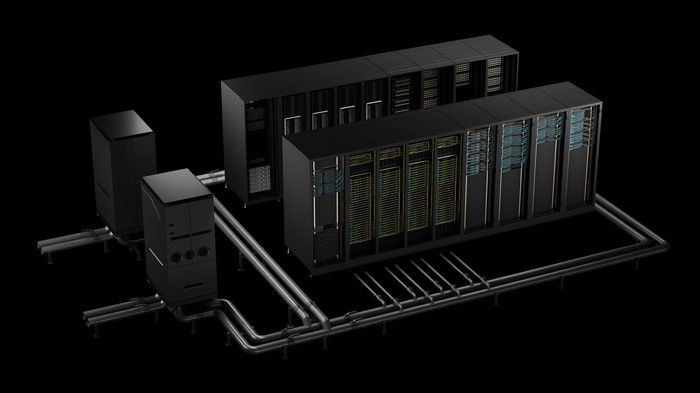컴퓨팅에서 처리해야 할 데이터가 기하급수적으로 빠르게 증가하는 반면 이를 처리해야 하는 프로세서의 연산은 데이터의 증가 속도를 따라잡기 못하고 있다. 이에 젠슨 황 CEO는 컴퓨테이션 인플레이션이 발생하고 있다면서 데이터센터의 비용과 전력량이 증가하고 있다고 설명했다.
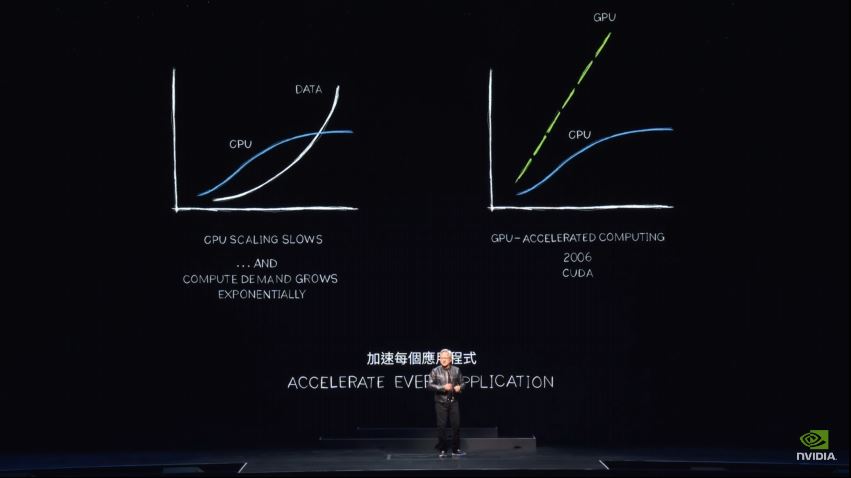
▲엔비디아 컴퓨텍스 2024의 한 장면. CPU의 스케일링은 점차 곡선이 완만해지는 반면 데이터 증가 곡선은 가팔라지고 있다.
HBM4 탑재한 차세대 루빈 플랫폼 조기 공개
옴니버스, 가속 컴퓨팅+AI=데이터의 시각화
MS 소외론 타파, RTX 기반 코파일럿 AI PC
데이터센터·AI 팩토리·로봇 팩토리 가속화 지원
컴퓨팅에서 처리해야 할 데이터가 기하급수적으로 빠르게 증가하는 반면 이를 처리해야 하는 프로세서의 연산은 데이터의 증가 속도를 따라잡기 못하고 있다. 이에 젠슨 황 CEO는 컴퓨테이션 인플레이션이 발생하고 있다면서 데이터센터의 비용과 전력량이 증가하고 있다고 설명했다.
엔비디아의 젠슨 황 CEO가 지난 컴퓨텍스 2024에서 인공지능의 확산 가운데 컴퓨팅과 반도체 영역이 당면한 해결과제를 돌파하기 위한 1년 주기로 출시되는 새로운 반도체 로드맵을 공개하며 기대감을 높였다.
■ 블랙웰 이을 차세대 루빈 플랫폼
처음으로 공개된 루빈(Rubin) 플랫폼은 곧 출시될 블랙웰(Blackwell) 플랫폼의 뒤를 이을 플랫폼이다. 루빈은 HBM4와 더불어 △새로운 GPU △새로운 Arm 기반 CPU인 베라 △NV링크 6 △CX9 슈퍼NIC △X1600 컨버지드 인피니밴드/이더넷 스위치를 탑재한 고급 네트워킹이 특징이다.
젠슨 황은 연설을 시작하면서 엔비디아는 데이터를 인텔리전스로 전환하는 데 드는 비용을 절감하고 있다고 말했다.
그는 “가속 컴퓨팅은 지속 가능한 컴퓨팅”이라고 강조하며, GPU와 CPU의 조합이 전력 소비를 단 3배만 증가시키면서 최대 100배의 속도 향상을 제공한다면서, CPU만 사용할 때보다 와트당 25배 더 높은 성능을 달성할 수 있다고 설명했다.
■ 옴니버스를 통한 데이터 시각화와 디지털 트윈 강조
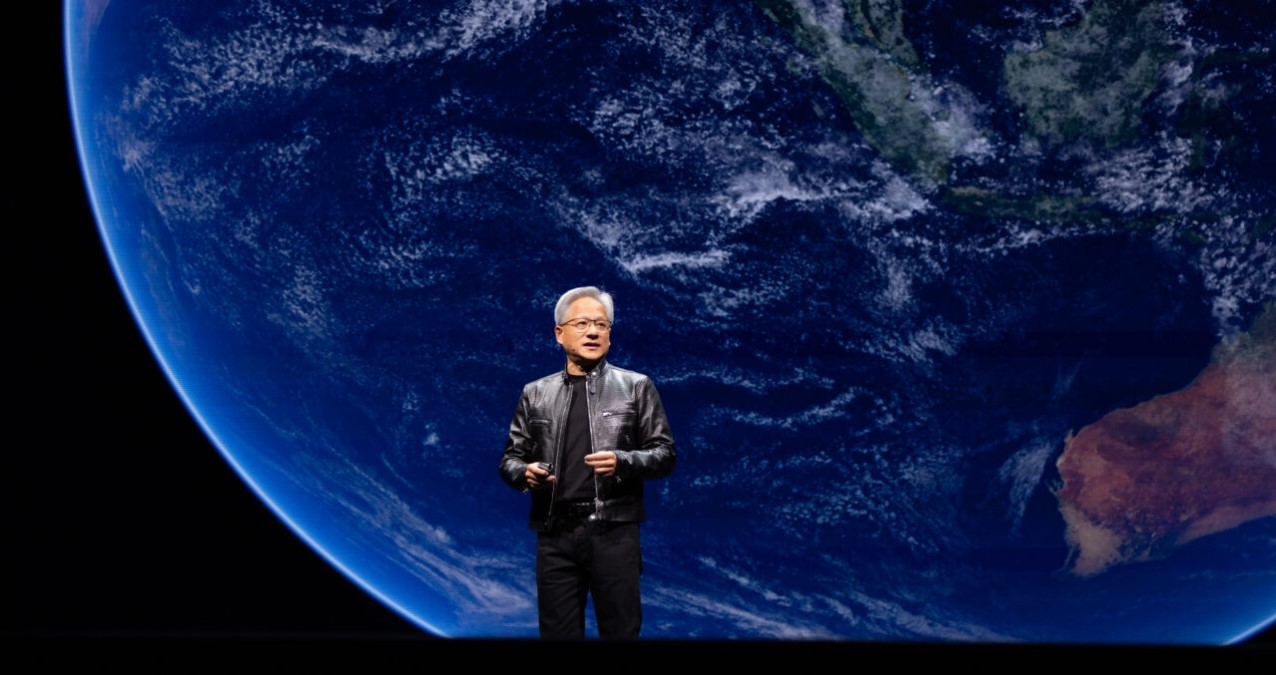 ▲엔비디아의 젠슨 황 CEO가 컴퓨텍스 2024에서 기조연설을 진행하며
▲엔비디아의 젠슨 황 CEO가 컴퓨텍스 2024에서 기조연설을 진행하며 Earth-2를 시연했다
. / (사진 : 엔비디아)
젠슨 황 CEO는 기조연설에서 “지난 60년 간 그저 몇 가지 주요 기술이 컴퓨팅의 산업의 패러다임을 전환하는 것을 보았으며 이제 다시 변화의 시기가 도래했다”면서 “옴니버스 안에서 실행되는 가속 컴퓨팅과 인공지능, 이 2가지 기술은 컴퓨팅의 근본적인 산업을 변화시킬 것이다”라고 말했다.
엔비디아는 NVIDIA 옵니버스(Omniverse)를 통한 데이터 연합 및 시각화를 강조하며 NVIDIA Earth-2를 비롯해 다양한 시뮬레이션 데모를 공개했다. 특히 Earth-2는 대화형 고해상도 시뮬레이션으로 기후 및 날씨 예측을 가속화하는 풀스택 개방형 플랫폼으로 킬로미터 규모의 기후 시뮬레이션을 다운사이징하는 생성형 AI 모델인 CorrDiff를 사용했다.
더불어 엔비디아 NIM과 엔비디아의 가속 컴퓨팅을 기반으로 구축된 엔비디아 인셉션 스타트업 프로그램 회원사의 AI 툴을 시연했다. 모델을 최적화된 컨테이너로 제공하는 추론 마이크로서비스인 NIM은 클라우드, 데이터센터 또는 워크스테이션에 배포할 수 있다.
△케이던스 △클라우데라 △코히시티 △데이터스택스 △넷앱 △스케일 AI △시높시스 등 200 여개의 기술 파트너가 NIM을 자사 플랫폼에 통합하고 있다. 이를 통해 △코파일럿 △코드 어시스턴트 △디지털 휴먼 아바타 등 도메인 특화 애플리케이션을 위한 생성형 AI 배포를 가속화한다. 허깅페이스는 현재 메타 라마 3부터 NIM을 제공한다고 전해졌다.
■ 지포스 RTX 기반 AI PC 출시 전망
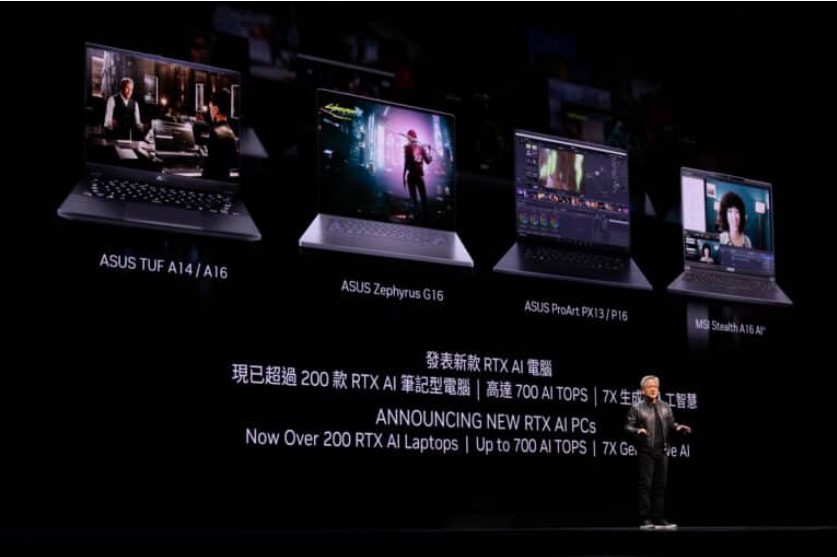
▲엔비디아 RTX AI PC / (사진 : 엔비디아)
엔비디아는 RTX 기술로 구동되는 엔비디아 RTX AI PC가 출시된다고 공개했다. 200개 이상의 RTX AI 노트북이 출시될 것으로 보이며 마이크로소프트(MS)의 윈도우 코파일럿을 지원할 것으로 전망된다.
MS와 엔비디아는 개발자들이 RTX 가속 SLM에 대한 간편한 API 액세스를 통해 윈도우 네이티브나 웹 앱에 새로운 생성형 AI 기능을 도입할 수 있도록 협력하고 있다. RTX 가속 SLM은 윈도우 코파일럿 런타임(Windows Copilot Runtime)의 일부로 디바이스에서 실행되는 RAG 기능을 지원한다.
RTX AI 툴킷과 새롭게 제공되는 엔비디아 ACE 디지털 휴먼 플랫폼용 PC 기반 NIM 추론 마이크로서비스는 AI 접근성을 가능케한다. 엔비디아는 AI 어시스턴트 기술 데모인 프로젝트 G-어시스트를 공개하며 PC 게임과 앱에 대한 상황 인식 지원 기술을 선보였다.
■ 데이터센터·AI 팩토리 구축 솔루션 공개
젠슨 황 CEO는 △애즈락 랙 △에이수스 △기가바이트 △인그라시스 △인벤텍 △페가트론 △QCT △슈퍼마이크로 △위스트론 △위윈 등이 엔비디아 GPU와 네트워킹을 사용해 클라우드, 온프레미스, 임베디드와 엣지 AI 시스템을 제공한다고 발표했다.
엔비디아 MGX 모듈식 레퍼런스 디자인 플랫폼은 거대 언어 모델(large language model, LLM) 추론, 검색 증강 생성(retrieval-augmented generation, RAG), 데이터 처리를 위한 GB200 NVL2 플랫폼이 포함되며 블랙웰을 지원한다.
NV링크(NVLink)®-C2C 인터커넥트와 블랙웰 아키텍처의 전용 압축 해제 엔진이 제공하는 고대역폭 메모리 성능을 활용하면 데이터 처리 속도가 최대 18배 빨라지고, x86 CPU를 사용할 때보다 에너지 효율이 8배 향상된다.
모든 유형의 애플리케이션에 대응하기 위해 단일 GPU부터 멀티 GPU, x86 기반 프로세서부터 그레이스 기반 프로세서, 공냉식부터 수냉식 기술까지 다양한 제품을 제공할 예정이다.
AMD와 인텔은 처음으로 자체 CPU 호스트 프로세서 모듈 설계를 제공할 계획으로 MGX 아키텍처를 지원하고 있다.
젠슨 황 CEO는 “차세대 산업 혁명이 시작됐다”고 언급하며 “수조 달러 규모의 기존 데이터센터를 가속 컴퓨팅으로 전환하고 새로운 유형의 데이터센터인 AI 팩토리를 구축해 새로운 상품인 인공지능을 생산하기 위해 기업과 국가들이 엔비디아와 협력하고 있다”고 말했다.
■ 엔비디아 산업용 AI, 로봇 팩토리 디지털화 가속
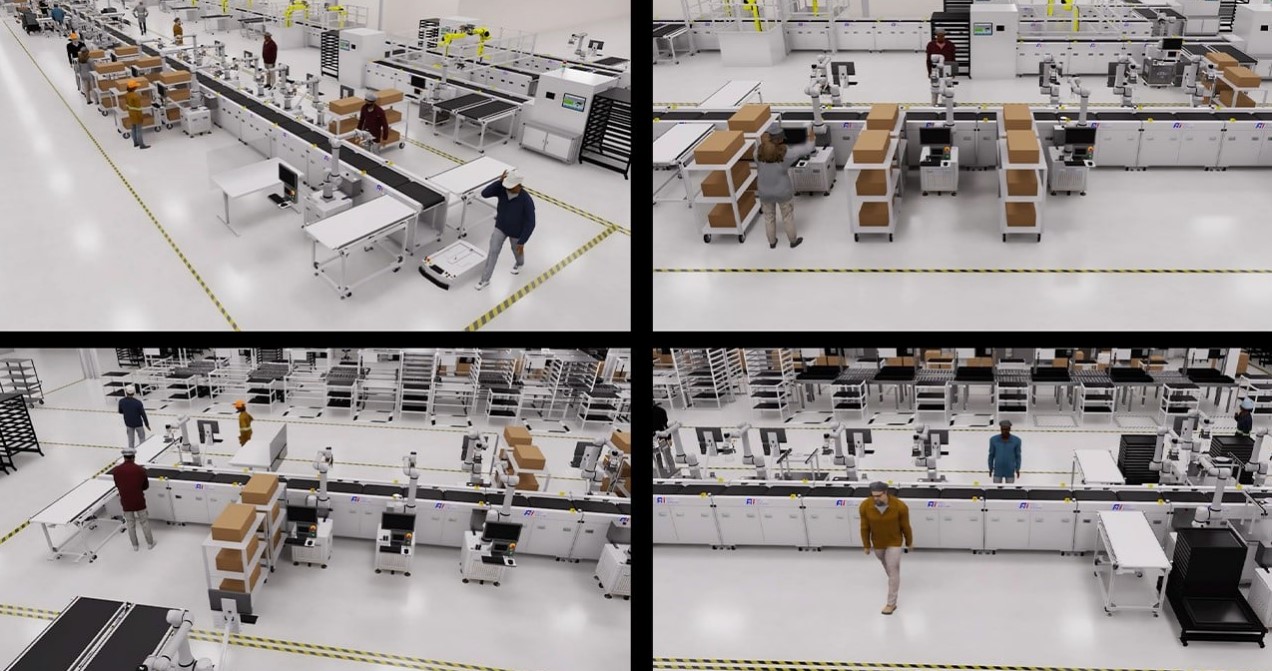
▲엔비디아, AI와 옴니버스로 로봇 공장 산업 디지털화 가속화 지원 사례 / (사진 : 엔비디아)
델타 일렉트로닉스, 폭스콘, 페가트론, 위스트론 등 대만 주요 전자 제조업체들이 엔비디아의 새로운 참조 워크플로우 기술을 통해 공장을 보다 자율적인 시설로 전환하고 있다고 발표했다.
제조업체들은 이러한 워크플로우를 활용해 실시간 공장 레이아웃 시뮬레이션을 위한 디지털 트윈을 구축했다. 이를 통해 제조업체들은 비용이 크게 들었을 실제 공장 변경 없이도 공간, 프로세스, 효율성을 최적화했다.
젠슨 황은 폭스콘이 엔비디아 옴니버스·아이작·메트로폴리스를 사용해 비전 AI와 로봇 개발 툴을 결합한 디지털 트윈을 만들어 로봇 설비를 개선한 사례를 소개했다.
글로벌 전자업체들은 엔비디아의 자율 로보틱스를 공장에 통합해 옴니버스에서 시뮬레이션을 활용하고, 물리적 세계를 위한 새로운 AI를 테스트 및 검증하고 있다. 여기에는 전세계적으로 사전 프로그래밍된 500만대 이상의 로봇이 포함된다.
젠슨 황은 “모든 공장이 로봇화될 것이다. 공장은 로봇을 조율하고, 로봇은 로봇화된 제품을 생산하게 될 것"이라고 설명했다.
디푸 탈라(Deepu Tala) 엔비디아 로보틱스 및 엣지 컴퓨팅 담당 부사장은 “제조업을 위한 AI등장으로 모든 공장은 생성형 AI와 디지털 트윈 기술의 혁신적인 영향으로 점점 자율화되고 있다”며 엔비디아 옴니버스, 메트로폴리스, 아이작 솔루션이 운영 효율성과 비용에 이점을 줄 수 있을 것으로 강조했다.


